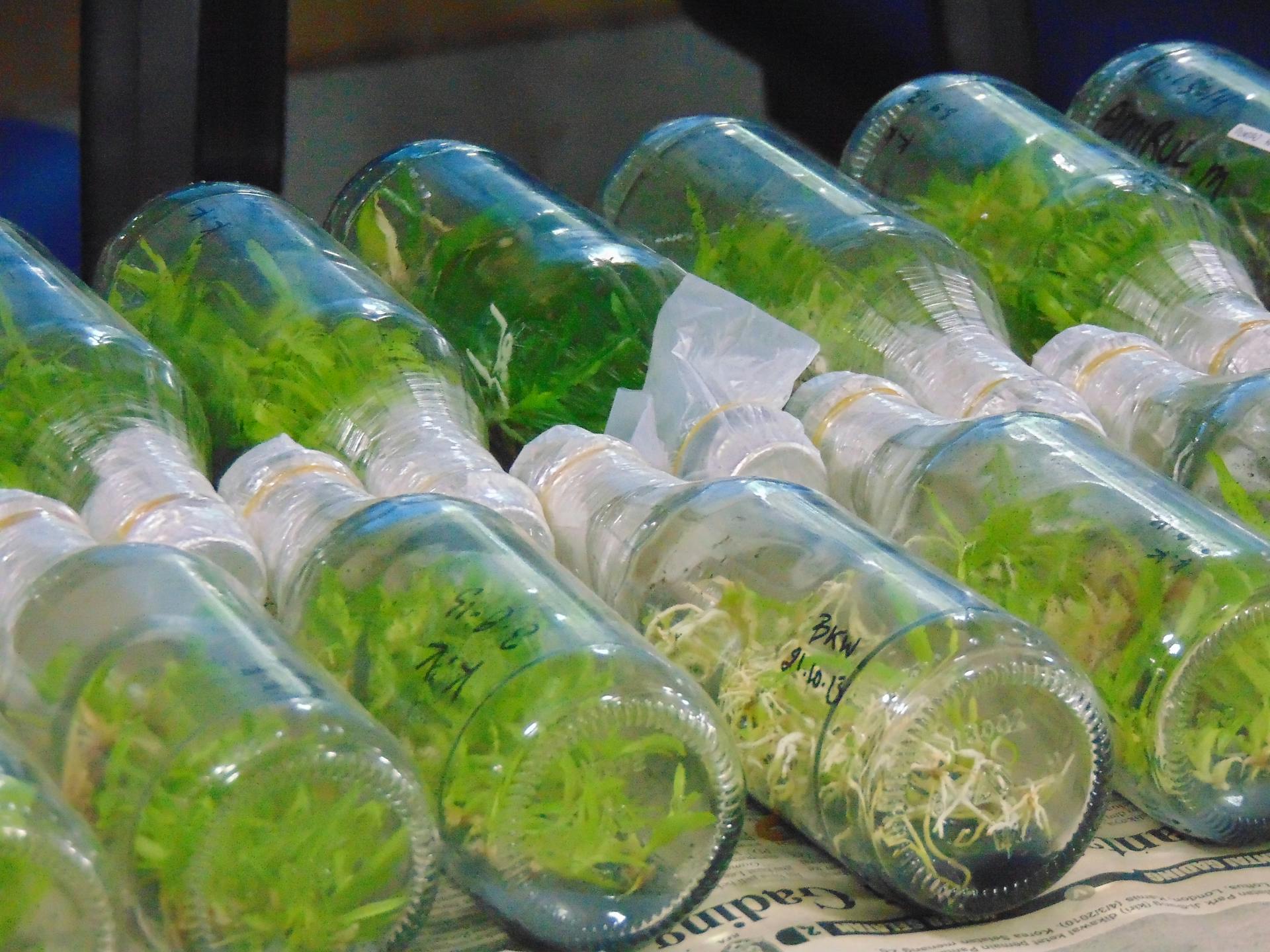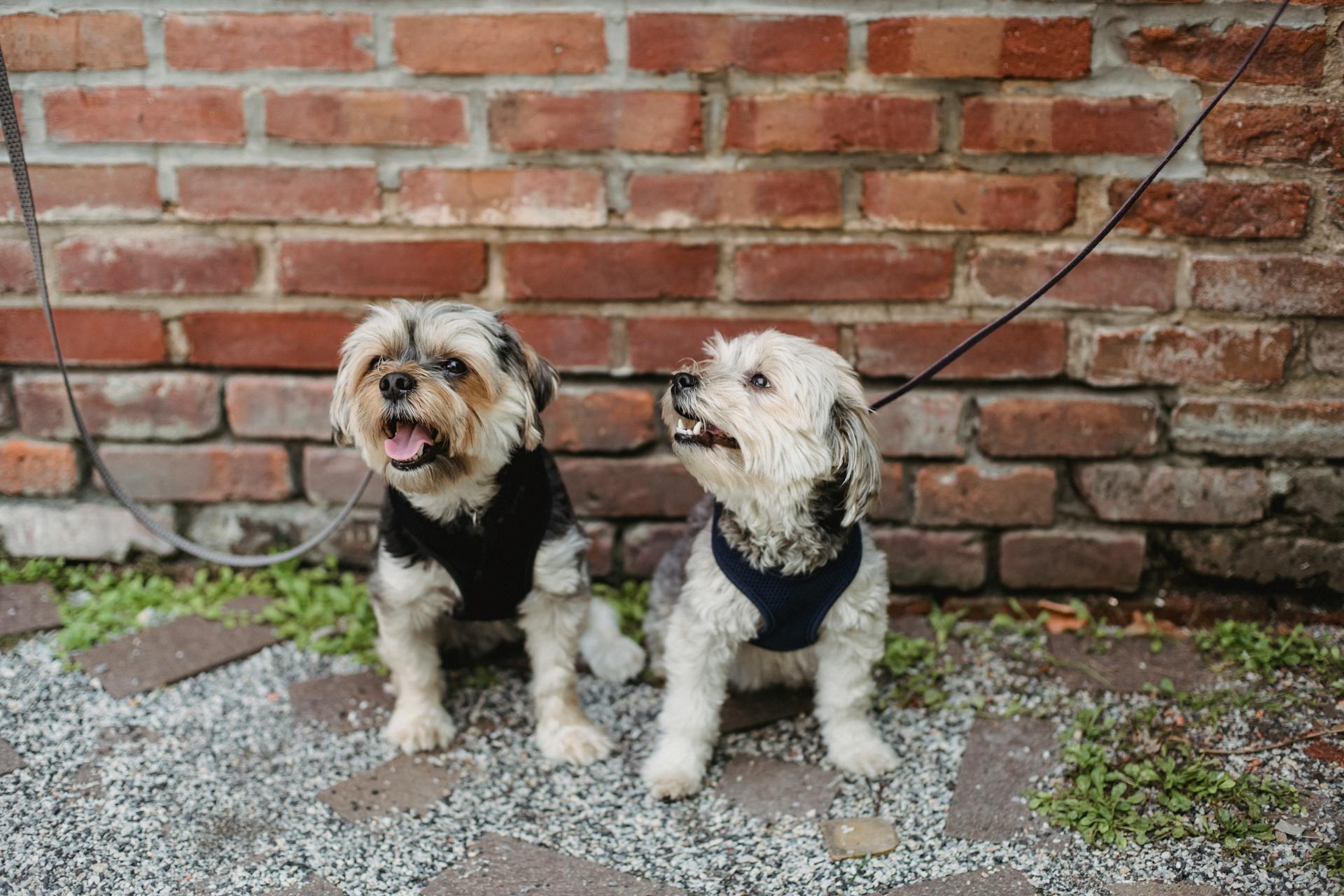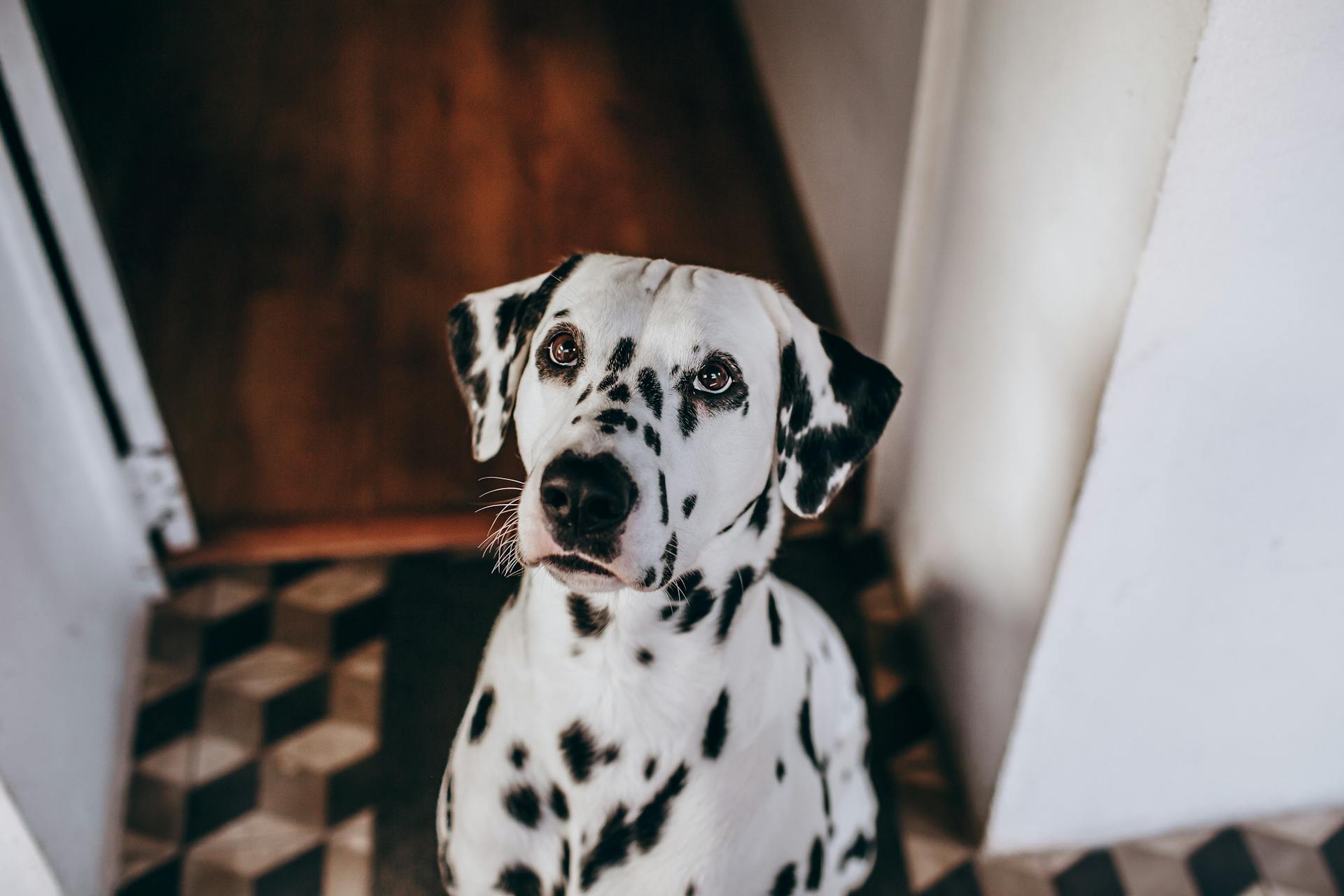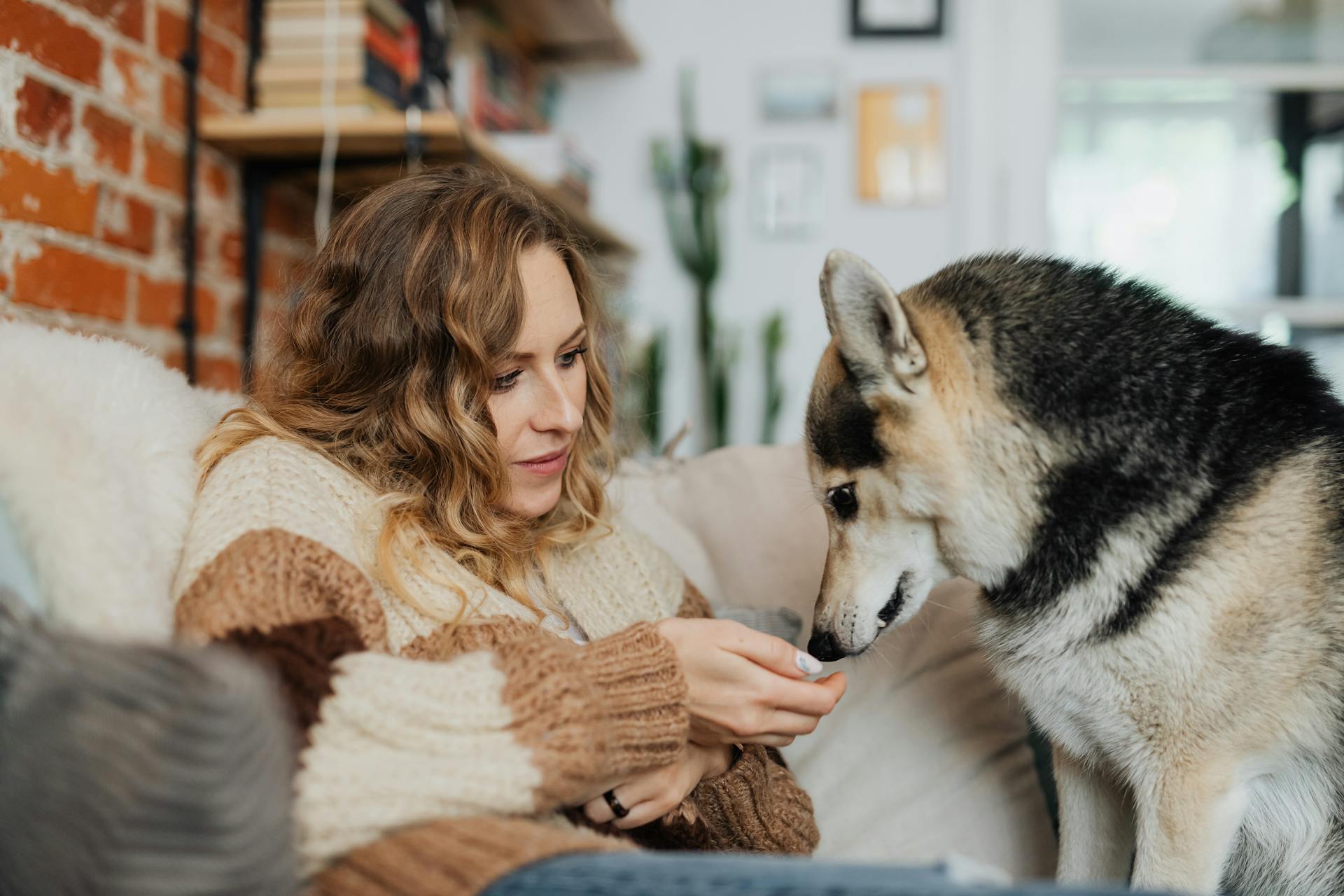
Cloning dogs has been around since 2005, when the first cloned dog, Snuppy, was born.
The cloning process involves taking a cell from the dog's body, usually from a cheek swab or blood sample, and using it to create an embryo. This embryo is then implanted into a surrogate mother, who carries the cloned puppy to term.
The cloning process is expensive, with costs ranging from $50,000 to $100,000 per cloning attempt.
If this caught your attention, see: How Does Dog Cloning Work
History of Cloning
The history of cloning dogs is a fascinating story.
After Dolly the sheep was cloned in 1996, scientists had managed to clone numerous other animals, but were unsuccessful in cloning a dog.
The first successful cloning of a dog was achieved by Woo Suk Hwang, a lead researcher at Seoul National University, using tissue from the ear of a 3-year-old Afghan hound.
123 surrogate mothers were used to carry the embryos, with 1,095 being implanted.
The procedure resulted in only three pregnancies, with one resulting in a miscarriage.
The successful clone was carried by a Labrador Retriever, and was named Snuppy as a portmanteau of the initials of the Seoul National University (SNU) and the word "puppy".
A fresh viewpoint: National Dog Show 2023 Dogs
The Cloning Process
The cloning process is a complex and delicate procedure that requires precise timing and monitoring. It can only be done during a three-week period each year, when the eggs in a female canine are fertile.
The eggs are extracted from the oviduct, which is a challenging task due to the complexities involved. The nucleus of each egg is then replaced with the cell from the ear of an adult dog.
The eggs are electrified and fused using a chemical reaction, and the resulting embryos are transferred to surrogate dogs. This process took nearly three years to complete in the case of Snuppy, the first cloned dog.
Step-by-Step
The Cloning Process can be broken down into a few key steps.
The first step is to identify the fertile eggs, which in canine reproduction only occur during the estrus phase of the estrous cycle, a three-week period each year.
The eggs are then extracted from the oviduct, a process that requires constant monitoring due to its complexities.
The nucleus of each egg is replaced with a cell from the ear of an adult dog.
The eggs are then electrified and fused using a chemical reaction.
The resulting embryos are transferred to surrogate dogs, who become pregnant.
Three surrogate mothers became pregnant and two gave birth, with Snuppy being the first to be born and the only one to survive.
Unsuccessful Process
The cloning process can be a lengthy and uncertain journey. Approximately 6-7% of total attempts have been successful.
Even with advanced technology, there's no guarantee of a successful outcome. This means that the majority of cloned animals may require heavy medical intervention.
This process can also lead to sensory impairment and other birth defects. The potential risks involved are not something you'd want your pet to go through.
Cloning Developments
Veterinary professor Byeong Chun Lee took over leadership of the team behind Snuppy and went on to clone over 30 dogs and five wolves.
The SNU team formed a license agreement with RNL Bio, a commercial pet cloning company, after claiming to own the patent for the process used to clone Snuppy.
RNL completed the first commercial cloning in August 2008, but later ran into financial trouble in 2013.
Breakthroughs
Breakthroughs in cloning technology have been rapid and significant.
In 1996, the first mammal, a sheep named Dolly, was cloned using somatic cell nuclear transfer (SCNT).
This breakthrough paved the way for further research into cloning mammals.
The technique was developed by Ian Wilmut and his team at the Roslin Institute in Scotland.
This was a major milestone in cloning developments.
Dolly's birth was announced to the world in February 1997, causing widespread media attention.
The cloning of Dolly was a significant achievement in the field of genetics.
She was cloned from an adult cell, which showed that it was possible to reverse the aging process in cells.
This discovery opened up new possibilities for cloning mammals.
Since Dolly's birth, numerous other mammals have been cloned using SCNT.
These include cats, dogs, and even a gaur, a type of wild cattle.
Cloning has also been used to preserve endangered species.
The Pyrenean ibex, for example, was cloned in 2009 using SCNT.
Advancements
Advancements in cloning technology have led to significant breakthroughs in recent years.
Scientists have successfully cloned mammals, including Dolly the sheep, who was cloned in 1996.
The first cloned human embryo was created in 2005, marking a major milestone in the field.
This achievement was made possible by the development of somatic cell nuclear transfer (SCNT) technology.
However, cloning a human being is still not possible due to the complexity of the human genome and the lack of a suitable surrogate mother.
Researchers are now exploring alternative methods, such as induced pluripotent stem cells (iPSCs), which can be used to create stem cells from adult cells.
These stem cells can then be used to generate tissues and organs, potentially revolutionizing the field of regenerative medicine.
Commercialization
Commercialization is a complex topic in the cloning industry. The first commercial cloning was completed by RNL in August 2008.
The company, RNL Bio, was involved in a license agreement with SNU, which claimed to own the patent for the process used to clone Snuppy. This agreement was a result of a partnership between RNL Bio and SNU.
However, a legal battle ensued between SNU and BioArts International, a competitor of RNL Bio, over patent rights. BioArts International eventually withdrew from dog cloning in 2009.
Sooam Biotech, founded by supporters of Hwang, developed proprietary techniques based on a license from ViaGen's subsidiary Start Licensing, which owns the original Dolly patent. The company has cloned over 700 dogs and produces 500 cloned embryos of various species daily.
Sinogene's Feng says the animals are treated with care and respect, and the company plans to clone working dogs like police dogs, guide dogs, and ordinary pets to ensure certain biological traits can be passed on.
Ethics and Legality
Cloned dogs like Longlong are raising concerns about ethics and legality.
People for the Ethical Treatment of Animals (PETA) has called Sinogene's research "unethical", citing the inherent cruelty and expense of cloning.
Cloning is not a new practice, but its use in China, where 20 million lab animals are used annually, has sparked debate.
The lack of legal protection for laboratory animals in China is a major concern, with lab animal welfare being one of the few areas of scientific research protected by law.
Little scholarly investigation has been done into the actual use or abuse of laboratory animals in China, making it difficult to assess the situation accurately.
Sinogene scientists believe their work aids pharmaceutical development and biomedical research, but the government is writing tougher regulations for lab animals, which are not yet clear.
Debating the Ethics
China is at the forefront of genetically customized animals, but this research has been met with ethical concerns. People for the Ethical Treatment of Animals (PETA) has called Sinogene's research "unethical" due to the inherent cruelty of cloning.
About 20 million lab animals, mostly mice, are used annually for testing in China. This is a staggering number, and it highlights the need for stricter regulations. China is a major producer and user of lab animals, and lab animal welfare is one of the few areas of scientific research protected by law.
Deborah Cao, an author and professor, has pointed out that enforcement and transparency on the humane treatment of lab animals is spotty in China. Little scholarly investigation has been done into the actual use or abuse of laboratory animals in China.
Cloning Legality
In the US, there is no law that bars the cloning of dogs. This means that, currently, cloning dogs is allowed.
The legality of dog cloning is a significant aspect to consider. A few countries have laws regulating the cloning of animals, but the US does not have any such laws.
In the US, the process of dog cloning is not prohibited by law. However, it's worth noting that laws can change over time, so it's essential to stay informed about any updates.
Dog cloning is a complex process, and its legality varies from country to country. The US is one of the countries where dog cloning is currently allowed.
Interesting Facts and Stories
The world of cloned dogs is a fascinating one! Scientists have successfully cloned a dog named Snuppy, who was born in 2005 and is considered the first cloned dog in the world.
Cloning a dog is a complex process that involves taking a cell from the dog's body and using it to create an exact genetic replica. This process is often compared to making a photocopy of a document.
The first cloned dog, Snuppy, was a male Afghan Hound who was cloned using somatic cell nuclear transfer (SCNT). This process involves taking a cell from the dog's body and transferring its nucleus into an egg cell.
Cloning a dog can be done for various reasons, including saving endangered breeds and creating customized pets. However, the process is still in its infancy and is not without its risks and challenges.
Interestingly, cloned dogs have the same genetic makeup as their donor parents, which means they will also have the same traits and characteristics. This is because the cloning process involves creating an exact genetic replica of the original dog.
Dog Cloning in China
Dog cloning is a booming business in China, with a company called SINOGENE receiving inquiries from across the country. The process involves removing the nucleus from a dog's egg and transplanting the nucleus of a cell from another dog.
Cloning a dog costs about $55,000, which may seem steep but the demand is already high and expected to soar in the future. The company is targeting 100 to 200 orders this year and 300 to 500 annually in a few years.
The company has a lab where it cultures the cells needed to create clones and uses surrogate mothers to give birth to the clone puppies. Most of the surrogate mothers are beagles, considered ideal due to their mild character.
The process of cloning a dog can be painful for the surrogate mothers, who often experience miscarriages or stillbirths. Even when a clone is successfully delivered, some are born with congenital disorders.
One of the first clients of SINOGENE was a woman named Xiao Bing from the city of Chongqing, who wanted to clone her 10-year-old dog Kandou. The cloning process involves taking a skin sample from the original dog, which is then sent to the lab in Beijing.
The cloned dog will be ready in about 10 months, and Xiao is willing to pay the steep price to have her beloved pet back. However, experts are raising concerns about the ethics of cloning pets, citing the potential harm to the surrogate mothers and the clones themselves.
Pros and Cons
The idea behind cloning a dog is to create a duplicate with specific traits. This process is ideal for pet owners who want to preserve their beloved dog's characteristics.
One of the main pros of cloning a dog is that it allows you to create a clone with certain traits or characteristics of the original dog. This is the idea behind the process.
Pros
Creating a clone of an existing dog can be a great idea if you want to replicate a specific trait or characteristic. The process aims to preserve the desirable qualities of the original dog.
You might want to clone a dog that excels in agility, hunting, or companionship, and have a new dog with the same skills.
Cons
The downsides of this topic are worth considering. One major con is that it can be time-consuming, requiring a significant investment of time and effort to achieve optimal results.
This is particularly true when working with complex systems, where even small mistakes can have major consequences. The potential for errors is high, which can be frustrating and costly.

On the other hand, some users may find the steep learning curve to be a challenge. This can be discouraging, especially for those who are new to the subject.
However, with patience and persistence, even the most difficult concepts can be mastered. It's essential to be aware of these potential drawbacks to make informed decisions.
Frequently Asked Questions
How long do cloned dogs live?
Cloned dogs can live a normal lifespan, with an average life expectancy similar to that of naturally bred dogs. However, individual longevity may vary, as seen in the case of Snuppy, the first cloned dog, who lived to be around 10 years old.
Do cloned dogs have the same personality?
Cloned dogs may share the same genes as their donor, but their personalities can differ due to variations in gene expression. Research suggests that cloned animals can have distinct personalities, just like naturally born pets.
How many dogs have been cloned?
Over 1500 dogs have been successfully cloned, representing a significant milestone in cloning technology. This achievement highlights the unique bond between humans and dogs, as well as their genetic similarity to us.
Has a dog been successfully cloned?
Yes, a dog was successfully cloned in 2005, with Snuppy, an Afghan hound puppy, being the first to achieve this feat. Since then, cloning has been used to help preserve endangered breeds, such as the Yakutian Laika.
Featured Images: pexels.com


